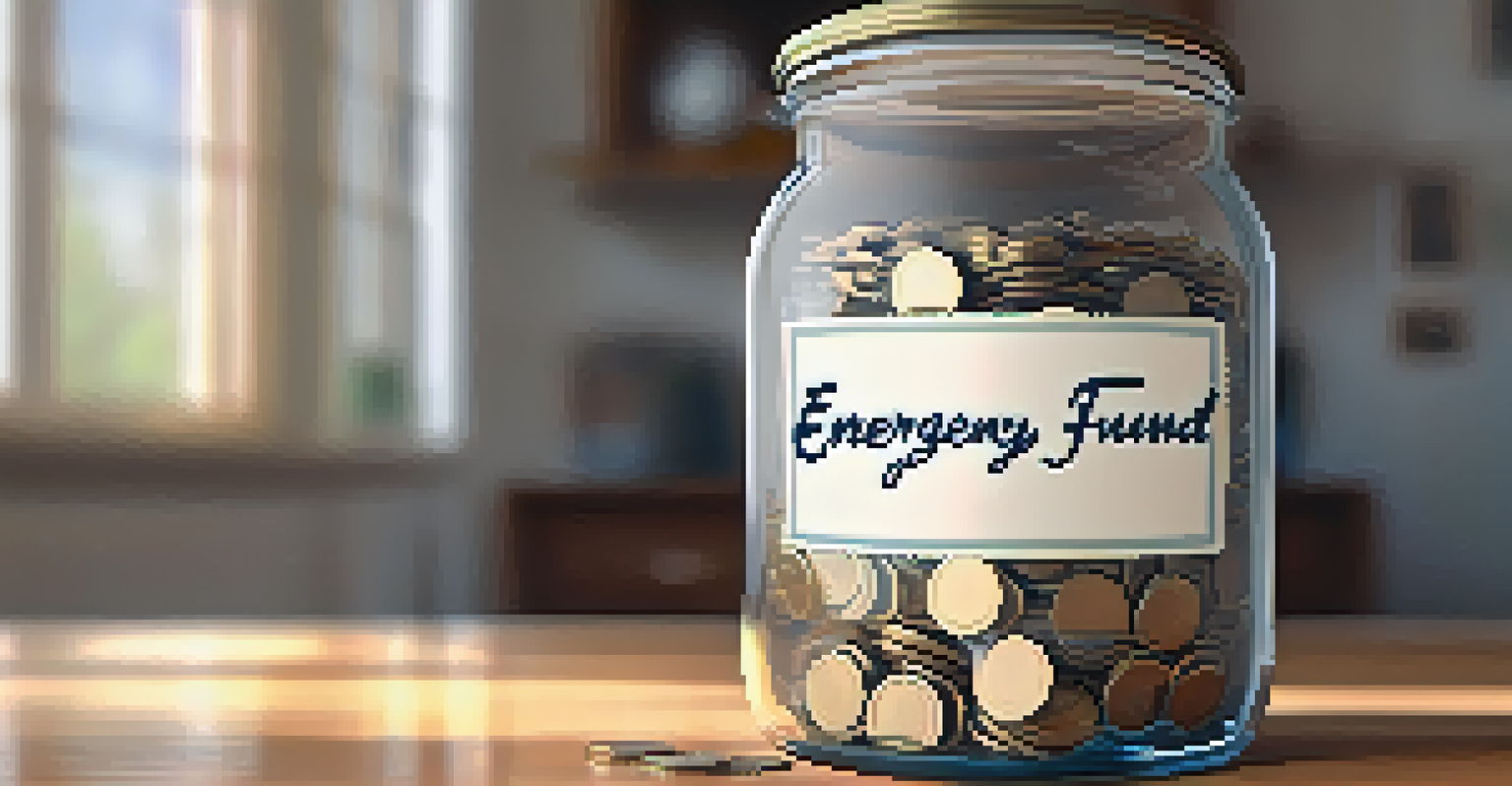Emergency Funds: A Safety Net for Financial Security

What Is an Emergency Fund and Why Is It Important?
An emergency fund is a savings buffer that helps you cover unexpected expenses, like medical bills or car repairs. Think of it as your financial safety net; it provides peace of mind during life's surprises. Without this cushion, you might find yourself relying on credit cards, which can lead to debt spirals.
An ounce of prevention is worth a pound of cure.
Having an emergency fund is crucial for financial stability. It allows you to tackle unforeseen challenges without derailing your budget or goals. Imagine needing a new heater in the middle of winter; an emergency fund lets you handle that without panic.
Generally, it’s recommended to save three to six months’ worth of living expenses. This amount varies based on your individual circumstances, like job security or health costs. The key is to find a figure that makes you feel secure.
How to Start Building Your Emergency Fund
Starting an emergency fund might feel daunting, but it can be broken down into manageable steps. Begin by setting a small, achievable goal—like saving $500. Once you hit that mark, you can gradually increase your target as you become more comfortable with saving.

Consider automating your savings to make the process easier. Set up a direct deposit from your paycheck into a separate savings account. This way, you won't be tempted to spend that money before it can serve its purpose.
Emergency Fund: Your Financial Safety Net
An emergency fund provides a crucial buffer against unexpected expenses, helping maintain financial stability.
Another tip is to cut back on non-essential expenses, even temporarily. For example, you could reduce dining out or cancel a subscription service. Those small sacrifices can add up quickly and fast-track your emergency fund.
Where to Keep Your Emergency Fund
Choosing the right place to store your emergency fund is just as important as saving it. You want an account that’s easily accessible, like a high-yield savings account or a money market account. This ensures you can quickly access your funds in case of an emergency.
Saving is a great habit, but without investing, it just sleeps.
Avoid putting your emergency savings in long-term investments, like stocks. These can be volatile, and the last thing you want during a financial crisis is to watch your savings fluctuate. Instead, opt for options that offer both security and some interest earnings.
Be mindful of fees associated with your savings account as well. Some banks have minimum balance requirements or monthly fees that can eat into your savings. Find a bank that offers favorable terms so your money can grow unimpeded.
How Much Should You Save for Emergencies?
Determining how much to save can depend on your personal situation. A good starting point is to aim for three months of essential expenses. This includes rent, groceries, utilities, and transportation—anything that keeps you afloat day-to-day.
If you have dependents or a less stable job situation, consider saving up to six months’ worth of expenses. This larger cushion can provide more security during times of uncertainty, like job loss or unexpected medical bills.
Start Small and Automate Savings
Begin by setting a manageable savings goal and consider automating contributions to build your emergency fund effortlessly.
Review your savings regularly to ensure you’re on track. Life changes, such as a new job or a growing family, may necessitate adjustments to your savings goal. Staying flexible will help you maintain your financial safety net.
Common Mistakes to Avoid with Emergency Funds
One of the biggest mistakes people make is not having an emergency fund at all. Even if you think you can handle emergencies as they arise, having that buffer can save you from financial stress. It’s better to prepare than to scramble during a crisis.
Another pitfall is using your emergency fund for non-emergencies, like a vacation or a new gadget. Remember, this fund is meant for genuine unexpected costs. If you find yourself dipping into it for everyday expenses, it might be time to reassess your budget.
Lastly, don’t forget to replenish your fund after using it. If you had to withdraw money for an emergency, make it a priority to rebuild that savings. A healthy emergency fund is an ongoing commitment to your financial well-being.
When to Use Your Emergency Fund Wisely
Knowing when to tap into your emergency fund is critical. Use it for genuine emergencies, such as unexpected medical expenses, car repairs, or job loss. These situations are exactly what the fund is designed for, offering you a financial lifeline.
Avoid using your fund for planned expenses, like a vacation or large purchases. While these may feel urgent, they’re not true emergencies. Instead, save separately for them to keep your emergency fund intact.
Use Funds Wisely for True Emergencies
It's essential to reserve your emergency fund for genuine unexpected costs, ensuring it remains intact for its intended purpose.
It's also essential to differentiate between what constitutes an emergency. If you're unsure, ask yourself: Would this expense impact my ability to meet my basic needs? If the answer is yes, then it’s likely a valid reason to use your emergency fund.
The Long-term Benefits of Having an Emergency Fund
An emergency fund not only protects you from financial shocks but also promotes peace of mind. Knowing you have a safety net reduces stress and allows you to focus on other life goals. It transforms your approach to finances from reactive to proactive.
With an emergency fund in place, you may find it easier to make significant life decisions, like changing jobs or moving. You won’t be as tethered to your current situation out of fear of the unknown. That freedom can lead to increased overall happiness and satisfaction.

Ultimately, building an emergency fund is a critical step toward financial independence. It empowers you to handle life’s ups and downs with confidence. The sooner you start, the sooner you can enjoy the benefits of financial security.